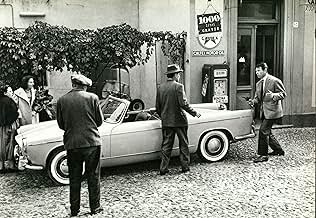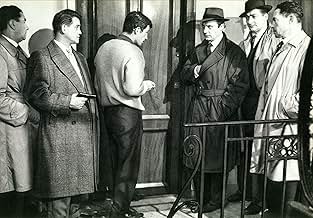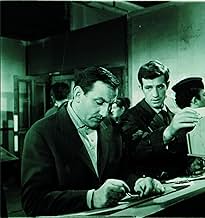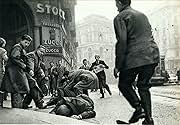IMDb रेटिंग
7.5/10
4.8 हज़ार
आपकी रेटिंग
अपनी भाषा में प्लॉट जोड़ेंA ruthless criminal flees from the pursuit, involving more and more casualties.A ruthless criminal flees from the pursuit, involving more and more casualties.A ruthless criminal flees from the pursuit, involving more and more casualties.
Simone Desmaison
- Thérèse Davos
- (as Simone France)
Jean-Pierre Zola
- Le patron de l'agence privée
- (as J.P. Zola)
Philippe March
- Jean Martin
- (as Aimé de March)
फ़ीचर्ड समीक्षाएं
The film Classe tous risques directed by Claude Sautet was not a film, to be honest, I had ever really heard of until the Film Forum in NYC said that they would have a 2-week screening of the film, with new English subtitles. When I also read that it was in the vein of the classic French crime films ala Jean Pierre Melville, I jumped at the chance to check it out (at best it would rank up with his great works, and at worst I would get some good popcorn in a great theater). It was well worth the admission, as Classe tous risques is one of those kinds of French films that is just waiting to be re-discovered (or discovered for the first time). With terrific, tense diligence, Sautet keeps the suspense at a tight pitch for the first forty minutes of the film, keeping a good (if not great) middle section, and then ending it up with what is always expected with these films, but with fascinating motivations by way of the characters. With a film in the vein of this sort, you know how it will end, but it's the cool, observant journey that counts.
The film features a performance with some real truth and honesty, amid the "old-school" criminal's code, by Lino Ventura as Aldo, who at the start of the film (one of the best beginnings to a film in this genre and country) steals a hefty amount of money with his partner in crime). When there is a sudden, ugly twist of fate on a beach late one night, Aldo is again on the run with two little kids. He gets the aid of Eric Stark (Jean-Paul Belmondo, a role in tune with Le Doulos only with a smidgen more humanity and charisma), who is also a thief and drives him into Paris. But there are some problems with some of Aldo's old business partner's, and one old score may be just the right ticket. A couple of times the plot may seem to be leisurely, but it isn't. Like Melville, Sautet doesn't allow any fat to his story, and it's a very tightly structured film, with some good doses of humor here and there (I was sometimes grinning at the audacity of the criminals in the beginning chase sequence, and also with a particular woman who had a finicky thing with her cat and a fish).
Along with a fine score by the great George Delerue, exceptional cinematography, and a mood that is seldom met let alone matched now adays, Classe tous risques is a reminder of that bridge between the real old-school film-noir, and the latter day crime films. Gangsters in these new sort of "thug-life" movies have a 1000th of the class and honor of the thieves in this film, and is a second banana to the works of Melville and Jules Dassin (a compliment I assure you). That it has a good realistic, moral edge helps as well.
The film features a performance with some real truth and honesty, amid the "old-school" criminal's code, by Lino Ventura as Aldo, who at the start of the film (one of the best beginnings to a film in this genre and country) steals a hefty amount of money with his partner in crime). When there is a sudden, ugly twist of fate on a beach late one night, Aldo is again on the run with two little kids. He gets the aid of Eric Stark (Jean-Paul Belmondo, a role in tune with Le Doulos only with a smidgen more humanity and charisma), who is also a thief and drives him into Paris. But there are some problems with some of Aldo's old business partner's, and one old score may be just the right ticket. A couple of times the plot may seem to be leisurely, but it isn't. Like Melville, Sautet doesn't allow any fat to his story, and it's a very tightly structured film, with some good doses of humor here and there (I was sometimes grinning at the audacity of the criminals in the beginning chase sequence, and also with a particular woman who had a finicky thing with her cat and a fish).
Along with a fine score by the great George Delerue, exceptional cinematography, and a mood that is seldom met let alone matched now adays, Classe tous risques is a reminder of that bridge between the real old-school film-noir, and the latter day crime films. Gangsters in these new sort of "thug-life" movies have a 1000th of the class and honor of the thieves in this film, and is a second banana to the works of Melville and Jules Dassin (a compliment I assure you). That it has a good realistic, moral edge helps as well.
"Classe tous risques" feels like the granddaddy of "The Sopranos" in mixing the criminal and the domestic, and of the buddy film to feel as contemporary as "Reservoir Dogs."
Even as these gangsters are affectionately entangled with wives, children, lovers and parents, they are coldly ruthless, and we are constantly reminded they are, no matter what warm situation we also see them in. They can tousle a kid's hair - and then shoot a threat in cold blood. The key is loyalty, and the male camaraderie is beautifully conveyed, without ethnic or class stereotypes, even as their web of past obligations and pay backs narrows into suspicion and paranoia, as the old gang is in various stages of parole, retirement, out on bail or into new, less profitable ventures. An intense accusation is of sending a stranger to perform an old escape scenario. It is a high point of emotion when a wife is told off that she's not the one the gangster is friends with, while virtually the only time we hear music on the soundtrack is when he recalls his wife.
Streetscapes in Italy and France are marvelously used, in blinding daylight to dark water and highways, from the opening set up of a pair of brazen robbers -- who are traveling with one's wife and two kids. Rugged, craggy Lino Ventura captures the screen immediately as the criminal dad. And the second thug is clearly a casually avuncular presence in their lives, as they smoothly coordinate the theft and escape, in cars, buses, on boats and motorcycles, in easy tandem. This is not the cliché crusty old guy softened with the big-eyed orphan; these are their jobs and their families and they intersect in horrific ways.
The film pulls no punches in unexpectedly killing off characters, directly and as collateral damage, and challenging our sympathy for them, right through to the unsentimental end, which is probably why there was never an American remake.
It seems so fresh that it's not until Jean-Paul Belmondo enters almost a third of the way into the film, looking so insouciant as a young punk, that one realizes that this is from 1960. Sultry Sandra Milo has smart and terrific chemistry with him, from an ambulance to an elevator to a hospital bed.
While the Film Forum was showing a new 35 mm print with newly translated subtitles, it was not pristine. The program notes explained that the title refers to a kind of insurance policy and is pun on "tourist class."
Even as these gangsters are affectionately entangled with wives, children, lovers and parents, they are coldly ruthless, and we are constantly reminded they are, no matter what warm situation we also see them in. They can tousle a kid's hair - and then shoot a threat in cold blood. The key is loyalty, and the male camaraderie is beautifully conveyed, without ethnic or class stereotypes, even as their web of past obligations and pay backs narrows into suspicion and paranoia, as the old gang is in various stages of parole, retirement, out on bail or into new, less profitable ventures. An intense accusation is of sending a stranger to perform an old escape scenario. It is a high point of emotion when a wife is told off that she's not the one the gangster is friends with, while virtually the only time we hear music on the soundtrack is when he recalls his wife.
Streetscapes in Italy and France are marvelously used, in blinding daylight to dark water and highways, from the opening set up of a pair of brazen robbers -- who are traveling with one's wife and two kids. Rugged, craggy Lino Ventura captures the screen immediately as the criminal dad. And the second thug is clearly a casually avuncular presence in their lives, as they smoothly coordinate the theft and escape, in cars, buses, on boats and motorcycles, in easy tandem. This is not the cliché crusty old guy softened with the big-eyed orphan; these are their jobs and their families and they intersect in horrific ways.
The film pulls no punches in unexpectedly killing off characters, directly and as collateral damage, and challenging our sympathy for them, right through to the unsentimental end, which is probably why there was never an American remake.
It seems so fresh that it's not until Jean-Paul Belmondo enters almost a third of the way into the film, looking so insouciant as a young punk, that one realizes that this is from 1960. Sultry Sandra Milo has smart and terrific chemistry with him, from an ambulance to an elevator to a hospital bed.
While the Film Forum was showing a new 35 mm print with newly translated subtitles, it was not pristine. The program notes explained that the title refers to a kind of insurance policy and is pun on "tourist class."
10urigafni
Odd one should be able to stumble into "Classe Tous Risques" only by chance; it should be on any "best of film-noir" list, including IMDb's.
Lino Ventura is as good as ever; knowing of his dire, delicate family situation gives extra weight to his almost expressionless face and brief dialogues. Belmondo's restrained performance under Sautet's firm direction only shows what a wonderful actor he could - and should -have been.
"Classe Tous Risques" is utterly mininal, dry and cold, without Melville's artistic scenery, pretty faces and fancy cars. It is almost film-noir meet neo-realism. Davos' few, hard words to his children describing their life of secrecy from there on get a hold on your throat to the end of the film.
The final sentence of the film - a voice-over telling of Davos' end in no more than ten dry, sombre words - leaves you with a hard punch in the stomach.
A true jewel in the great crown of French film-noir.
Lino Ventura is as good as ever; knowing of his dire, delicate family situation gives extra weight to his almost expressionless face and brief dialogues. Belmondo's restrained performance under Sautet's firm direction only shows what a wonderful actor he could - and should -have been.
"Classe Tous Risques" is utterly mininal, dry and cold, without Melville's artistic scenery, pretty faces and fancy cars. It is almost film-noir meet neo-realism. Davos' few, hard words to his children describing their life of secrecy from there on get a hold on your throat to the end of the film.
The final sentence of the film - a voice-over telling of Davos' end in no more than ten dry, sombre words - leaves you with a hard punch in the stomach.
A true jewel in the great crown of French film-noir.
In Milan, the gangster Abel Davos (Lino Ventura) is sentenced to death "In absentia" and decides to return to France. Abel is a family man with wife Thérèse Davos (Simone France) and two sons, and his partner Raymond Naldi (Stan Krol) helps Abel and his family to flee to Nice. However Thérèse and Raymond are killed by the police and Abel uses his former friends in Paris to help him to go to Paris with his sons. They hire the driver Eric Stark (Jean-Paul Belmondo) to bring Abel and his kids to Paris in an ambulance. Along their journey, Eric helps the aspirant actress Liliane (Sandra Milo) on the road and she also goes to Paris in the ambulance. But soon Abel learns that he is alone and his friends when he was powerful will not help him and he counts only with the support of Eric. What will happen to him?
"Classe tous risques" is a great film-noir with the story of the last days of a gangster. The plot shows that there is no code of honor or friendship after the fall of a powerful gangster. All his former friends do not help him when he needs. The conclusion is adequate for the whole situation. My vote is eight.
Title (Brazil):"Como Fera Encurralada" ("Like Trapped Beast")
"Classe tous risques" is a great film-noir with the story of the last days of a gangster. The plot shows that there is no code of honor or friendship after the fall of a powerful gangster. All his former friends do not help him when he needs. The conclusion is adequate for the whole situation. My vote is eight.
Title (Brazil):"Como Fera Encurralada" ("Like Trapped Beast")
Classe Tous Risques (The Big Risk) is repeatedly recommended every time I look up a Jean-Pierre Melville film that I had to give it a watch as soon as possible. Since I've been discovering Melville and seemingly working backwards through his filmography, it would be easy for me to mistake this as one of his films, but it was made in 1960, by Claude Sautet, before Melville would come and stake his claim on french neo-noir.
Classe Tous Risques has two of the best lead men of the time, Lino Ventura and Jean-Paul Belmondo. Ventura plays Abel, a gangster exiled in Italy with his wife and two kids, who wants to come back to Paris because the police are closing in on him. After a roaring and fast paced opening with a big surprise, Abel eventually gets hooked up with Eric Stark (Belmondo) who wants to get into the criminal underworld. Stark becomes Abel's chauffeur and eventual only friend in an underworld that turns it's back on Abel after everything he's done and been through. The film shows the the duality of the two men, the older Abel at the end of his time after tragedy strikes him, and the younger Eric starting off the same way Abel did, falling in love with a beautiful woman who sticks with her man despite the world they are a part of. It never ends pretty for them, or their loved ones. Its one thing to see a individual criminal come to his demise, its different when he has loved ones he risks taking down with him.
Much like Melville's film, the seemingly simple story gets more subtlety complicated as it goes along. As usual, as what I feel with Melville's films, it left my head spinning (in a good way) and dying to re watch it again to pick up what I missed the first time. Classe Tous Risques is a definite keeper.
Classe Tous Risques has two of the best lead men of the time, Lino Ventura and Jean-Paul Belmondo. Ventura plays Abel, a gangster exiled in Italy with his wife and two kids, who wants to come back to Paris because the police are closing in on him. After a roaring and fast paced opening with a big surprise, Abel eventually gets hooked up with Eric Stark (Belmondo) who wants to get into the criminal underworld. Stark becomes Abel's chauffeur and eventual only friend in an underworld that turns it's back on Abel after everything he's done and been through. The film shows the the duality of the two men, the older Abel at the end of his time after tragedy strikes him, and the younger Eric starting off the same way Abel did, falling in love with a beautiful woman who sticks with her man despite the world they are a part of. It never ends pretty for them, or their loved ones. Its one thing to see a individual criminal come to his demise, its different when he has loved ones he risks taking down with him.
Much like Melville's film, the seemingly simple story gets more subtlety complicated as it goes along. As usual, as what I feel with Melville's films, it left my head spinning (in a good way) and dying to re watch it again to pick up what I missed the first time. Classe Tous Risques is a definite keeper.
क्या आपको पता है
- ट्रिवियाCo-writer/Director Claude Sautet said after the shooting that he did not know that the Abel Davos - Danos - character was inspired by a gangster who collaborated with the Nazis against French resistance and Jews during German occupation.
- भाव
Eric Stark: The best thing about me is my left hook.
- कनेक्शनFeatured in Claude Sautet ou La magie invisible (2003)
टॉप पसंद
रेटिंग देने के लिए साइन-इन करें और वैयक्तिकृत सुझावों के लिए वॉचलिस्ट करें
- How long is The Big Risk?Alexa द्वारा संचालित
विवरण
बॉक्स ऑफ़िस
- US और कनाडा में सकल
- $1,32,928
- US और कनाडा में पहले सप्ताह में कुल कमाई
- $11,945
- 20 नव॰ 2005
- दुनिया भर में सकल
- $1,32,928
- चलने की अवधि
- 1 घं 50 मि(110 min)
- रंग
- पक्ष अनुपात
- 1.66 : 1
इस पेज में योगदान दें
किसी बदलाव का सुझाव दें या अनुपलब्ध कॉन्टेंट जोड़ें



































